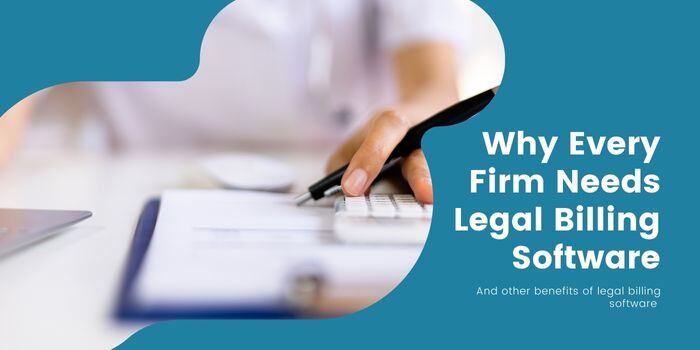The Importance of Simple Legal Billing
Legal billing is a crucial aspect of running a successful law firm, and having the right tools in place can make all the difference. It's critical to streamline the billing process to save time, and ultimately improve the firm's bottom line. By following best practices, leveraging the power of technology to track time accurately, and streamlining the entire process, law firm cash flow remains steady. Don't let legal billing be a headache for your firm - let software streamline your processes and focus on delivering quality legal services to your clients.
Legal Billing Best Practices
When it comes to legal billing, there are certain best practices that help ensure accuracy and efficiency. One important practice is to clearly outline the scope of work and the fee structure in your engagement letter. This helps manage client expectations and prevent any disputes down the line. And, it's important to track your time accurately and consistently, whether billing hourly, flat fee, or other fee structures. Using a time tracking tool helps keep a detailed record of the tasks worked on and the time spent on each task. Finally, it's crucial to regularly review and analyze billing data to identify any trends or areas for improvement.
Another important best practice is to establish a billing schedule and stick to it. This means sending out invoices on a regular basis and following up with clients who have outstanding payments. By setting clear expectations and enforcing a billing schedule, firms can maintain a steady cash flow and avoid any unnecessary delays or disputes.
When considering best practices for legal billing, it's essential to also think about clients and offering them convenient options for payment. Providing different payment methods can make the process smoother and more efficient for all parties involved. By integrating popular payment gateways into the billing process, clients have the flexibility to pay invoices online with ease. This not only enhances the overall client experience but also helps ensure timely payments, improving cash flow for your firm. Keeping the client's needs in mind when setting up the billing process can lead to a more positive and productive relationship, ultimately benefiting both parties in the long run.
Overall, following these best practices helps streamline the legal billing process and ensure that the firm is getting paid for the services completed in a timely manner.
Streamlining Legal Billing Processes
The key is in how the firm implements best practices. Using case management software reduces duplicate entry and improves accuracy. Using one software platform where time and expenses are tracked, along with related matter details like documents, appointments, tasks, and more, users leverage a single resource to make invoicing simple. No need to track hours in one spot and then create invoices.
Look for software that lets the firm customize the time tracking process and gives the firm insights to determine where and how time is spent. Some firms track both billable and non-billable time, by activity. Not only does this give the firm more reliable billable time results as tracking time is required no matter what the user is doing, it also gives the firm insight as to where that non-billable time is being spent. The right software lets the firm customize the activity type, too. Does your firm want to know how much time is spent with leads? Perhaps time in court? Whatever you want to track, the case management software should let you decide and customize it too. And, of course, what good is that data if you can't create reports to give the firm the information needed to truly understand how time is spent.
Billing Types
Hourly, flat fee, and contingency billing are quite common. Would your clients appreciate a subscription model? Think of it as spread out payments for any flat fee matter. Perhaps a client pays 50% of the total up front and the remaining 50% over the course of the next 3 months. Whatever the payment schedule is, look for software that gives the firm that option. Like SimpleLaw.
Does your firm utilize retainers or advance fee payment? Be sure to find a software platform that makes it simple. From the initial trust payment, requesting additional funds, tracking and paying invoices, and even showing non-firm related outflows, the right software makes it simple to administer trust payments.
By streamlining your legal billing processes, firms reduce the time and effort spent on administrative tasks and focus more on delivering quality legal services to clients.
Streamline Payment Processing
Processing payments can be a time-consuming and cumbersome task for legal professionals. Look for software that streamlines the payment process too, making it more convenient for the firm and clients. Easily generate and send invoices to clients via email via client portal access. There are many benefits of the client portal, including viewing and paying invoices. Clients view their matter, 24/7, seeing appointments, tasks, notes, and they can upload documents or complete intake forms too.
Look for software that gives firms the option to add an online payment link on the invoice. Not only does this make it simple for clients to pay their invoices, they generally submit payments sooner, too. Look for software that offers some online payment integrations as well as external online payment partners.
By streamlining the payment processing with our software, you can improve cash flow, reduce administrative burden, and provide a seamless payment experience for your clients.
SimpleLaw Features
Our software offers a range of features designed to simplify and streamline your legal billing process. Some of the key features include:
- Time tracking: Easily track and record your time spent on different tasks and matters. Whether added manually or using the responsive time tracking tool. Each matter has it's own responsive time tracker, too.
- Expense tracking: Keep track of matter expenses and easily include them in your invoices, too. Want to create separate invoices for expenses versus services? No problem.
- Invoicing: Create and send professional invoices to your clients with just a few clicks. With multiple layouts, online payment link on each invoice, and the option to show outstanding balance and trust balance, too.
- Billing reports: Generate detailed billing reports to gain insights into your billing activity. See outstanding balances at the click of a button. Same for trust balance. Average days outstanding? Sure. With our powerful reporting tool, get the insights your firm needs.
- Integration with payment gateways: Seamlessly process online payments from your clients without requiring manual entry.
- Client portal: Provide your clients with a secure portal where they can view and pay their invoices. But that's just the beginning. Clients also see appointments, tasks, complete intake forms, upload documents, and more.
Simple legal billing starts with the attorney-client agreement. From there, look for technology that streamlines the process of executing that agreement. Time and expense tracking, simplified invoice creation, and online payment processing saves the firm valuable time and improves overall cash flow.

